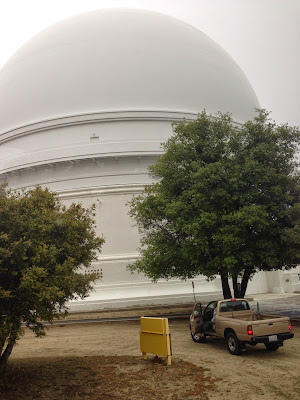Today, I visited the Palomar Observatory in the mountains
north of San Diego. Palomar has an extensive history of astronomical discovery
throughout the twentieth century, and continues to be in use today. The
observatory is home to a massive 200 inch telescope built and operated by
Caltech. The size of the telescope—200 inches—refers to the diameter of the
primary mirror of the telescope, and is a good measure of a telescope’s light
collecting power. A series of five other mirrors help to focus the light and
direct it to various instruments, including a spectrometer, the housing of
which I was allowed to climb inside! The entire assembly itself is housed in a
massive dome with the same diameter of the ancient Roman Pantheon. Our tour
guide stressed that the huge dome and extensive support structures were all
designed to protect and align a thin layer of aluminum weighing only five grams
in total.
Unlike the everyday mirrors in bathrooms which owe their
reflectivity to silver surfaces, Palomar uses aluminum to create its mirrors.
Silver mirrors use a simple chemical process to coat glass, called the Tollen's test. At Palomar,
aluminum deposition onto its glass primary is carried out in a precisely
controlled vacuum environment in order to ensure the mirror is devoid of
imperfections. When making telescopes, minuscule imperfections can be a big
problem. Any deviation from a perfectly parabolic surface will scatter or blur
the valuable image the telescope aims to collect. Imperfections of sizes
comparable to the wavelength of the observed light (in this case, visible
light, which is several tenths of a micron in wavelength) can compromise the
instrument. Much care is taken in order to hunt down these tiny flaws on a
giant mirror for this reason. Every two to three years, the aluminum on the
mirror is carefully stripped and recoated using the same high-precision process
in order to repair the accumulation of dust and foreign material (read: bird
droppings) that accumulate from nightly use.
Below are some panoramas I took from various locations under the dome. The primary mirror is located under the big structure and is currently pointed straight up. The large cylindrical tank is the vacuum chamber where the mirror is repaired.
Below are some panoramas I took from various locations under the dome. The primary mirror is located under the big structure and is currently pointed straight up. The large cylindrical tank is the vacuum chamber where the mirror is repaired.
Here is a view from the south end of the telescope. The hole on the left is where I got to enter the telescope. The cage on the top of the telescope is the observing platform, and is separated from the rest of the telescope in order to isolate the vibrations of whoever was observing. Today, electronic instruments take data instead of astronomers' eyes.


No comments:
Post a Comment